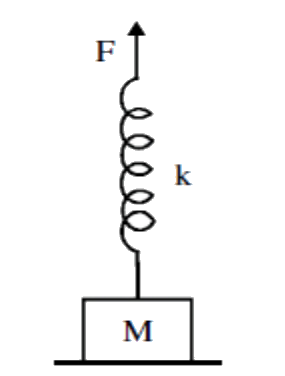A cubical block 'A' of mass m0(=a3ρ=3kg) of edge 'a' and density ρ floats in a liquid of density 3ρ. The lower surface of the cube just touches the free end of massless spring of spring of spring constant k(=a2ρg) fixed at the bottom of the vessel. Another block 'B' of mass 'm' is lept over block 'A', so that is completely immersed in liquid without wetting the block 'B'. Then find the value of m in kg.
The correct Answer is:8
To solve the problem step by step, we need to analyze the forces acting on the cubical block 'A' and the additional block 'B' that is placed on top of it.
1. Identify the Given Data:
- Mass of block 'A', m0=3kg
- Density of block 'A', ρ
- Edge length of block 'A', a
- Density of liquid, Density=3ρ
- Spring constant, k=a2ρg
2. Calculate the Volume of Block 'A':
VA=a3
3. Calculate the Weight of Block 'A':
WA=m0g=3gN
4. Calculate the Buoyant Force Acting on Block 'A':
- The buoyant force FB is given by Archimedes' principle:
FB=Density of liquid×Volume submerged×g
- Initially, block 'A' is floating, and let x be the submerged height. The volume submerged is A⋅x=a2x:
FB=3ρ⋅a2x⋅g
5. Equilibrium Condition for Block 'A':
- At equilibrium, the weight of block 'A' equals the buoyant force:
WA=FB⟹3g=3ρa2xg
- Cancel g from both sides:
3=3ρa2x⟹x=1ρa2
6. Determine the Height of Block 'A' Above the Liquid:
- The height of block 'A' above the liquid is:
h=a−x=a−13a=23a
7. When Block 'B' is Placed on Block 'A':
- When block 'B' of mass m is placed on block 'A', it becomes fully submerged. The total downward force now includes the weight of block 'B':
Wtotal=WA+mg=3g+mg
8. Calculate the New Buoyant Force:
- The entire volume of block 'A' is submerged, so:
FB=3ρ⋅a3⋅g
9. Set Up the New Equilibrium Condition:
- The new equilibrium condition gives:
3g+mg=3ρa3g
10. Substituting Known Values:
- We know m0=3kg corresponds to ρa3=3:
3+m=9⟹m=9−3=6kg
11. Final Result:
- The value of mass m is:
m=6kg
- Mass of block 'A', m0=3kg
- Density of block 'A', ρ
- Edge length of block 'A', a
- Density of liquid, Density=3ρ
- Spring constant, k=a2ρg
VA=a3
WA=m0g=3gN
- The buoyant force FB is given by Archimedes' principle:
FB=Density of liquid×Volume submerged×g
- Initially, block 'A' is floating, and let x be the submerged height. The volume submerged is A⋅x=a2x:
FB=3ρ⋅a2x⋅g
- At equilibrium, the weight of block 'A' equals the buoyant force:
WA=FB⟹3g=3ρa2xg
- Cancel g from both sides:
3=3ρa2x⟹x=1ρa2
- The height of block 'A' above the liquid is:
h=a−x=a−13a=23a
- When block 'B' of mass m is placed on block 'A', it becomes fully submerged. The total downward force now includes the weight of block 'B':
Wtotal=WA+mg=3g+mg
- The entire volume of block 'A' is submerged, so:
FB=3ρ⋅a3⋅g
- The new equilibrium condition gives:
3g+mg=3ρa3g
- We know m0=3kg corresponds to ρa3=3:
3+m=9⟹m=9−3=6kg
- The value of mass m is:
m=6kg
Topper's Solved these Questions
- PROPERTIES OF MATTERBOOK - DC PANDEY ENGLISHCHAPTER - PROPERTIES OF MATTEREXERCISE - Matrix Matching
12 Videos
- PROJECTILE MOTIONBOOK - DC PANDEY ENGLISHCHAPTER - PROJECTILE MOTIONEXERCISE - Level - 2 Subjective
10 Videos
- RAY OPTICSBOOK - DC PANDEY ENGLISHCHAPTER - RAY OPTICSEXERCISE - Integer type q.
14 Videos
Similar Questions
A cubical block of wood of edge a and density ρ floats in water of density 2ρ. The lower surface of the cube just touches the free end of a mass less spring of force constant K fixed at the bottom of the vessel. The weight W put over the block so that it is completely immersed in water without wetting the weight is
View SolutionA body of density ρ sinks in a liquid of density ρL.The densities ρ and ρL are related as:
View SolutionA block of density ρ floats in a liquid with its one third volume immersed. The density of the liquid is
View SolutionA drop of liquid of density ρ is floating half-immersed in a liquid of density d. If σ is the surface tension the diameter of the drop of the liquid is
View SolutionA solid cube of side a and density ρ0 floats on the surface of a liquid of density ρ. If the cube is slightly pushed downward, then it oscillates simple harmonically with a period of
View SolutionA cubical block of wood of edge 3 cm floats in water. The lower surface of the cube just touches the free end of a vertical spring fixed at the bottom of the pot. Find the maximum weight that can be put on the block without wetting it. Density of wood =800kgm−3 and spring constant of the spring =50Nm−1Takeg=10ms−2.
 ,
,
View SolutionA cubical block of wood of edge 3 cm floats in water. The lower surface of the cube just touches the free end of a vertical spring fixed at the bottom of the pot. Find the maximum weight that can be put on the block without wetting it. Density of wood =800kgm−3 and spring constant of the spring =50Nm−1Takeg=10ms−2.
 ,
,
View SolutionA block of 2 kg is suspended from the ceiling through a massless spring of spring constant k=100 N/m. What is the elongation of the spring? If another 1 kg is added to the block, what would be the further elongation?
View SolutionA block of volume V and density ρ is floating in a liquid of density 2ρ filled in a vessel. Now the vesset starts falling freely with acceleration g. Then the volume of block inside the liquid in the falling condition is
View SolutionA block of mass m is kept on a rough horizontal surface and is attached with a massless spring of force constant k. The minimum constant force applied on the other end of the spring of lift the block is

View Solution
